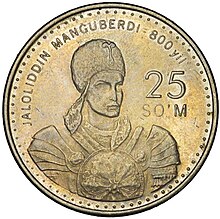| Jalal al-Din Mangburni | |
|---|---|
 Uzbek 25 soʻm coin commemorating Jalal al-Din | |
| Khwarazmshah | |
| Reign | 1220 – August 1231 |
| Born | Gurganj |
| Died | August 1231 Silvan, Diyarbakır |
| Spouse |
|
| Dynasty | Anushtegin dynasty |
| Father | Muhammad II |
| Mother | Ay-Chichek |
| Religion | Sunni Islam |
Jalal al-Din Mangburni (Persian: جلال الدین مِنکُبِرنی), also known as Jalal al-Din Khwarazmshah (جلال الدین خوارزمشاه), was the last Khwarazmshah of the Anushtegin dynasty. The eldest son and successor of Ala ad-Din Muhammad II of the Khwarazmian Empire, Jalal al-Din was brought up at Gurganj, the wealthy capital of the Khwarazmid homeland. An able general, he served as second-in-command to his father in at least one battle; however, since he was the son of a concubine, he was challenged as successor by a younger brother, whose cause was supported by the powerful Queen Mother, Terken Khatun. Nevertheless, after the Mongol conquest of the Khwarazmian Empire led to his father's flight and death on an island in the Caspian Sea, Jalal-al Din gained the loyalty of the majority of Khwarazmian loyalists.
The new Shah Jalal al-Din moved to Gurganj, but departed eastwards after Terken Khatun moved against him; evading Mongol patrols, he gathered a substantial army at Ghazni. He managed to inflict an excellent defeat on Shigi Qutuqu at the Battle of Parwan, but soon lost a good portion of his army in a dispute over spoils. He was defeated by a vengeful Genghis Khan at the Battle of the Indus, and fled across the river. Now essentially a warlord, Jalal al-Din managed to establish a succession of short-lived states: first in the Punjab from 1222 to 1224, and then in northwest Iran and Georgia after 1225. Jalal al-Din did not have the political ability needed to underpin his martial exploits, and he was forced to combat several large revolts and increasing pressure from Mongol forces. Eventually, he was killed in August 1231. The army he had gathered would continue to terrorize the Levant as the mercenary Khwarazmiyya until its final defeat in 1246.